牛津英语(新)区级公开课8A Unit 6 CW 教案8A Unit 6 Natural Disasters
8A Unit6教案全部
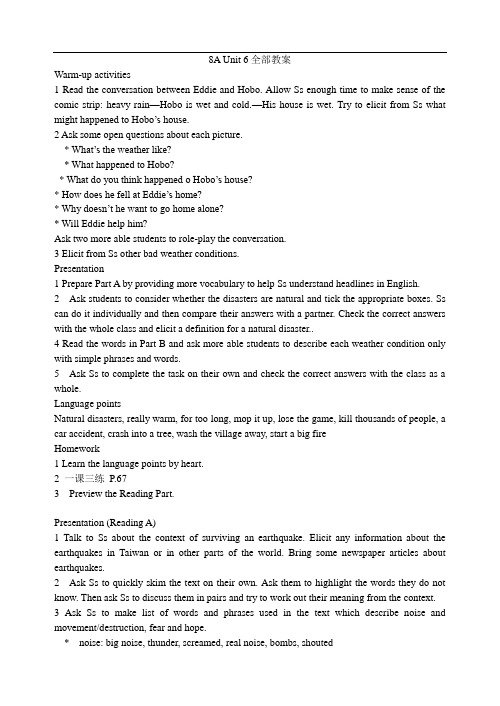
8A Unit 6全部教案Warm-up activities1 Read the conversation between Eddie and Hobo. Allow Ss enough time to make sense of the comic strip: heavy rain—Hobo is wet and cold.—His house is wet. Try to elicit from Ss what might happened to Hobo’s house.2 Ask some open questions about each picture.* What’s the weather like?* What happened to Hobo?* What do you think happened o Hobo’s house?* How does he fell at Eddie’s home?* Why doesn’t he want to go home alone?* Will Eddie help him?Ask two more able students to role-play the conversation.3 Elicit from Ss other bad weather conditions.Presentation1 Prepare Part A by providing more vocabulary to help Ss understand headlines in English.2 Ask students to consider whether the disasters are natural and tick the appropriate boxes. Ss can do it individually and then compare their answers with a partner. Check the correct answers with the whole class and elicit a definition for a natural disaster..4 Read the words in Part B and ask more able students to describe each weather condition only with simple phrases and words.5 Ask Ss to complete the task on their own and check the correct answers with the class as a whole.Language pointsNatural disasters, really warm, for too long, mop it up, lose the game, kill thousands of people, a car accident, crash into a tree, wash the village away, start a big fireHomework1 Learn the language points by heart.2 一课三练P.673 Preview the Reading Part.Presentation (Reading A)1 Talk to Ss about the context of surviving an earthquake. Elicit any information about the earthquakes in Taiwan or in other parts of the world. Bring some newspaper articles about earthquakes.2 Ask Ss to quickly skim the text on their own. Ask them to highlight the words they do not know. Then ask Ss to discuss them in pairs and try to work out their meaning from the context.3 Ask Ss to make list of words and phrases used in the text which describe noise and movement/destruction, fear and hope.* noise: big noise, thunder, screamed, real noise, bombs, shouted* movement/destruction: slight shaking, earth started to shake, ran (wildly), pieces of glass and bricks fell down, walls began to come down* fear: screamed, frightened, dark, could not at all, a moment of fear* hope: calm down, still alive, bright daylight, safe4 Read Timmy’s story aloud. Ask Ss to listen carefully.5 Check general understanding of the different paragraphs by asking some ‘ wh-‘ questions. Para 1: Where was Timmy?What happened in the shopping centre?Para 2: What happened to the building?How did people react?What did Timmy do?Para 3: Where was Timmy when the shaking stopped?How did Timmy feel?Para 4: What did Timmy do while he was waiting for help?Para 5: How was he rescued?Presentation (Reading B)1 Explain the context of Part B. Ask students to do Part B1 on their own. Encourage students to check their answer with a partner.3 Ask students to study the words in the box for one minute, then cover them and complete the diary entry in Part B2.Presentation (Reading C)1 Explain the context and point out to Ss the idea of telling a story with pictures. Divide the class into teams of 4-5 students to study each picture first.2 Ss write the captions in the blanks individually. Check answers with the whole class.3 Ask Ss to arrange the pictures in the right order.Presentation (Reading D)1 Explain the context and remind them about story telling from memory. Ss work in pairs to complete the task.2 Check the answers with the whole class.Language points (Part A)Feel a slight shaking through my body, a big noise like thunder, in fear, be frightened, start to shake, run in all directions, know where to go, run wildly, fall down, calm down, be over, could not see at all, be trapped, say to oneself, a moment of fear, go through my mind, since, hear excited shouts, in a great hurry, move away, see the bright daylight.Language points (Part C)Be very good at telling jokes, voteHomework1 Learn the language points by heart.2 一课三练P.68-693Preview the V ocabulary Part.当前中学英语课堂教学存在的主要问题及对策林会猛[ 摘要] :中学英语课堂教学是提高教学质量的关键。
牛津8A-U6-Reading 教学设计

宜兴市杨巷中学
戚婷婷
Fun with English -8A
Unit 6 Natural Disasters
( Reading )
一、教学任务分析
教材分析: Unit 6 Natural disasters
--Reading
Module 1 Teenage life Module 2 Nature and environment
U6Reading
The Taiwan Earthquake Please find out the
difficult words and expressions !
Read the passage aБайду номын сангаасd replace the underlined parts.
thunder
scream
calm down be trapped
1. The wolf was kept in a place and could not was trapped move and was caught by the hunter. 2. I shouted loudly when I saw a snake. screamed 3. At the beginning I was very nervous, but I stop being nervous now. calmed down
Exercises
二、用所给词的适当形式填空。(4%*5)
1. The girls are all _____________ (frighten) of the frightened
darkness(黑暗).
牛津 8A
八年级英语上册 Unit6精品教学案(Word版共10课时) 牛津译林版
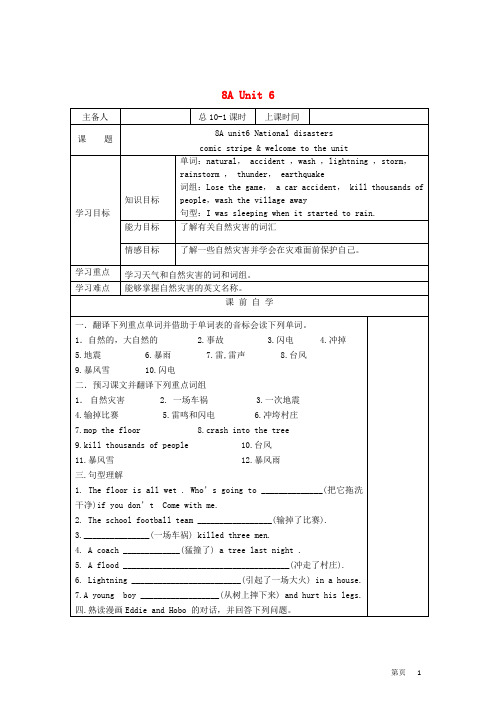
8A Unit 6导学案导学案导学案导学案(1) (2) (3) 1. He is swimming now.(He ______ swimming at this time yesterday导学案导学案导学案导学案导学案8A 导学案参考答案8A unit6课时10-1的答案:(一)1.thunder and lightning 2.washed 3.natural 4.accident 5.an earthquake6.rainstorm7.lost 8.crashed(二)1.earthquake 2.storm 3.rainstorm 4.snowstorm 5.typhoon(三)1.lives 2.natural 3.thousands4.people 5.sleeping(四) washed a lot of houses and trees away.killed thousands of peoplefell from a treestarted a big fire in the buildingin the accident课时10-2的答案:(一) 1.shopping 2. felt 3.like 4.directions 5. best 6.wet 7.shaking 8.fear9.screamed 10.calmed 11.since(二) 1.loudly 2.broken 3.real 4.himself 5.survivor(三) 1.shopping2.slight 3.thunder 4.fear 5.real6.directions 7.tried 8.wildly9.while 10.bricks课时10-3的答案:(一)1.in fear 2.ran in all direction 3.are trying our best 4.screamed wildly 5.calmed down 6.were trapped(二)1.because 2.turn off 3.to calm down 4.was trapped 5.in all directions(三)1.shaking 2.frightened 3.alive 4.herself 5. trapped 6. wildly , 7.are mopping(四)略课时10-4的答案:(一)drop a little ,become worse , 降到5度, 7度左右(二)1.rainy , raining 2.worse 3.snowy 4.windy, 5.cloudy sunny 6. foggy fog 7. will be , 8.stormy(三)1.was foggy 2.was a heavy rain 3.snowed 4.will be frosty(四) temperature , above , below , to , cold, hot, thank , near课时10-5的答案:(一)1.搜寻因特网 2.stand at the side of the road 3.a terrible snowstorm4.开车送你去学校5.break down6.和Danial讨论课题(二)1.was doing 2.were listening 3.was searching 4.were discussing 5.was visiting(三)1.He wasn’t doing his homework at 8 last night.2.My brother was watching TV at 4 p.m. yesterday.3.What was your father doing at that moment?4.When was he writing a letter?5.What’s the weather like today?(四) ing the mobile phone 2.broke down 3.were mopping up the water4.waiting for a bus5.will lost the game课时10-6的答案:(一)1.wasn’t playing 2.left ,was eating 3.was searching 4.were dancing ,were singing5.were playing6.were talking(二)1.while / when 2.when 3. while/ when 4. while/ when 5. while/ when 6. while/ when 7.when 8.when(三)1.My mum was cooking while my dad was reading newspaper.2.When the teacher came in ,the students were chatting with each other3.When the children were having lessons, the earthquake started.4.When I was doing some shopping ,suddently I heard a big noise like thunder.课时10-7的答案:(一)1.一个事故报道 2.覆盖整个路面 3.call 110 for help 4.be trapped in the car5.weather condition6.受难者的情况7.到达时间 8 send them to hospital(二)1.into 2.because 3.about 4.at 5.to 6.with(三)1.can be dangerous 2.with mobile phone3.was really heavy 4.hit him 5.wasn’t hurt 6.was trapped(四)1.hear, happened, heavy , lightning, really , caught , hit, hurt, holiday , was课时10-8的答案:(一)1. ↘2. ↘3. ↗4. ↘5. ↘6. ↘7. ↘8. ↗(二)1.terrible2. arrival 3.heavy 4.lock 5.covers 6.seriously7.caller 8.conditions(三)1.was 2.rained 3.worse 4.called 5.were trapped 6.be课时10-9的答案:略课时10-10的答案:(一)1.people in need 2.give out the food 3.干净的饮用水4. 可怕的状况5.社会工作者6.local people(二)1.washed away 2.was snowy 3.were trapped 4.turn off 5.at last 6.say to himself7.try my best 8.because(三)1.arrival 2.heavy 3. warning 4. frosty(四)1.to 2.with 3.of . at 4.in 5.at fo r at 6. for, on 7.around 8. away。
牛津英语8aunit6教案

8A Unit 6全部教案Warm-up activities1 Read the conversation between Eddie and Hobo. Allow Ss enough time to make sense of the comic strip: heavy rain—Hobo is wet and cold.—His house is wet. Try to elicit from Ss what might happened to Hobo’s house.2 Ask some open questions about each picture.* What’s the weather like?* What happened to Hobo?* What do you think happened o Hobo’s house?* How does he fell at Eddie’s home?* Why doesn’t he want to go home alone?* Will Eddie help him?Ask two more able students to role-play the conversation.3 Elicit from Ss other bad weather conditions.Presentation1 Prepare Part A by providing more vocabulary to help Ss understand headlines in English.2 Ask students to consider whether the disasters are natural and tick the appropriate boxes. Ss can do it individually and then compare their answers with a partner. Check the correct answers with the whole class and elicit a definition for a natural disaster..4 Read the words in Part B and ask more able students to describe each weather condition only with simple phrases and words.5 Ask Ss to complete the task on their own and check the correct answers with the class as a whole.Language pointsNatural disasters, really warm, for too long, mop it up, lose the game, kill thousands of people, a car accident, crash into a tree, wash the village away, start a big fireHomework1 Learn the language points by heart.2 一课三练P.673 Preview the Reading Part.Presentation (Reading A)1 Talk to Ss about the context of surviving an earthquake. Elicit any information about the earthquakes in Taiwan or in other parts of the world. Bring some newspaper articles about earthquakes.2 Ask Ss to quickly skim the text on their own. Ask them to highlight the words they do not know. Then ask Ss to discuss them in pairs and try to work out their meaning from the context.3 Ask Ss to make list of words and phrases used in the text which describe noise and movement/destruction, fear and hope.* noise: big noise, thunder, screamed, real noise, bombs, shouted* movement/destruction: slight shaking, earth started to shake, ran (wildly), pieces of glass and bricks fell down, walls began to come down* fear: screamed, frightened, dark, could not at all, a moment of fear* hope: calm down, still alive, bright daylight, safe4 Read Timmy’s story aloud. Ask Ss to listen carefully.5 Check general understanding of the different paragraphs by asking some ‘ wh-‘ questions. Para 1: Where was Timmy?What happened in the shopping centre?Para 2: What happened to the building?How did people react?What did Timmy do?Para 3: Where was Timmy when the shaking stopped?How did Timmy feel?Para 4: What did Timmy do while he was waiting for help?Para 5: How was he rescued?Presentation (Reading B)1 Explain the context of Part B. Ask students to do Part B1 on their own. Encourage students to check their answer with a partner.3 Ask students to study the words in the box for one minute, then cover them and complete the diary entry in Part B2.Presentation (Reading C)1 Explain the context and point out to Ss the idea of telling a story with pictures. Divide the class into teams of 4-5 students to study each picture first.2 Ss write the captions in the blanks individually. Check answers with the whole class.3 Ask Ss to arrange the pictures in the right order.Presentation (Reading D)1 Explain the context and remind them about story telling from memory. Ss work in pairs to complete the task.2 Check the answers with the whole class.Language points (Part A)Feel a slight shaking through my body, a big noise like thunder, in fear, be frightened, start to shake, run in all directions, know where to go, run wildly, fall down, calm down, be over, could not see at all, be trapped, say to oneself, a moment of fear, go through my mind, since, hear excited shouts, in a great hurry, move away, see the bright daylight.Language points (Part C)Be very good at telling jokes, voteHomework1 Learn the language points by heart.2 一课三练P.68-693Preview the V ocabulary Part.当前中学英语课堂教学存在的主要问题及对策林会猛[ 摘要] :中学英语课堂教学是提高教学质量的关键。
牛津8A_unit6_全单元教学案导学案讲学稿

第2课时
课题
Reading(A)
课型
新授
教学目标
知识目标
1.Todevelopstudents’reading skills (skimming and scanning).
2. To gettheusefulinformation of the text.
3. To guessthemeaning of words and expressions inthetext.
教学过程
教师活动
学生活动
Step 1. Pre-checking
词组翻译
1.在一个购物中心_____________________________
2.恐惧地互相看着______________________________
3.破碎玻璃片_________________________________
4.一阵恐惧___________________________________
5.吃一包巧克力_______________________________
6.a slight shaking _______________________________
7.run in all directing ____________________________
4.The radio says that there __________(be) a snowstorm tomorrow.
5.I _______________(do) my homework when my mother got home yesterday.
Ⅱ.Show some pictures to talk about common weather
2018-2019学年译林牛津英语初二上册8AUnit 6 全单元教案

课题8A Unit 6 Welcome to this unit 课型New教学目标To learn the common names of birdsTo talk about birds on two aspects: characteristics and appearance. To arouse the students’ interest in birds in the wild教学重点To learn the common names of birds教学难点To talk about birds on two aspects: characteristics and appearance.教学过程教师内容备课札记Step 1 Presentation1.Talking about birdsShow the pictures of different kinds of birds and talk aboutthem focusing on what’s special about the b irds.Learn the new words (Revise some old words at the sametime, like wing/ feather/ beak)2.Do Part A on Page75.Step 2. Practice1.Show the pictures together and then get the students togive their names. Make sure all the students can read thenames correctly.2.Play a game: reading and guessing (guess what bird it is.)e.g. I live in wetland. I am very tall. I have long beak,long neck and long legs. I have black and white feathers.Who am I? (a crane)3.Ask the studentsWhich is your favorite bird? Why?Practice Part B on Page75 in pairsStep 3. ProductionMake up new conversations using Part B as a model and actthem out.Step 4. Presentation1.Say: We love birds. Eddie loves birds, too. Listen to thetape and find the answers to the following questions.1) What is Eddie going to do?2) Does he really love birds?3) What kind of birds does he like best?2.Practice reading in pairs and try to act it out.Step 5. Production1.Choose a kind of birds and describe its appearance using the new words.2.Do some exercises.1) I hope to go ____________ (birdwatch) someday.2) Among all the birds, I like cranes _______ (good).3) How many _____ (type) of tigers are there in the world?4) The other ________ (wing) of the bird was hurt.Step6 HomeworkWrite a short passage about your favorite bird (5-6sentences) .板书设计教学反思课题8A Unit 6 Reading (1) 课型New教学目标To develop the ability to infer the general meaning from title and context.To reinforce students ability to skim text for overall meaning and scan for details. To encourage the students to join Birdwatching Club.教学重点To develop the ability to infer the general meaning from title and context.教学难点To reinforce students ability to skim text for overall meaning and scan for details教学过程教师内容备课札记Step 1: Presentation1.Ask the students to talk about their favourite birds.A: Which bird do you like best?B: I like the …best.A: Why?B: Because…2. 教师通过提问,引出生词及课题:①Do you like the red-crowned cranes? Why?②Are there many red-crowned cranes in China now?(No, there are not many red-crowned cranes in China,they are rare and endangered.)③Where do they live?(They live in Zhalong——Aspecial place.) It is a nature reserve.3.Finish part B1 on page 78Step 2: Fast reading1.Listen to the tape and finish part C1 on page 792.Read the article by yourselves and divide it into two partsPart1 Something about ZhalongPart2 Different people’s thoughts(想法) and actions(行为)Step 3:Further reading1.Listen to part 1 again and answer the following questions(1)Where is Zhalong?(2)What is Zhalong?(3)Why is Zhalong an ideal home for wildlife?(4) How long do the birds live in Zhalong every year?(5) Why can many birds live comfortably in Zhalong?2. Retell part 1 according to the keywords on the blackboard.3. Read part2 by yourselves and finish the table.people thoughts and actions some peoplethe Chinesegovernmenta lot of touristsmembers of the Birdwatching Club ①②③④⑤many people4. Retell part 2 according to the keywords in the table.Step 4. PracticeDiscussion:We know there are fewer and fewer birds in the world ,then how can we protect the birds? Give your useful advice.Step 5 Homework:1.Recite the new words and recite the passage aboutred-crowned cranes.2. Do B2 on Page 78 and C2 on Page 79.板书设计教学反思课题8A Unit 6 Reading (2) 课型New教学目标1. To get more detailed information about Zhalong Nature Reserve.2. To analyze the sentences for the students to get a better understanding.3. To make sure the students know the importance of wetlands and nature reserves教学重点To get more detailed information about Zhalong Nature Reserve.教学难点To analyze the sentences for the students to get a better understanding.教学过程教师内容备课札记Step 1 Revision1. Answer some questions about Zhalong?(1)Where is Zhalong?(2) Is Zhalong Nature Reserve a good place for wildlife? Why?(3)Are there many red-crowned cranes in the world? Why?(4)Why are more and more birds in danger?(5)What actions should we take to protect the wildlife?Step 2 Language points.1. in north-east China = in the north-east of China西北___________ 东南_____________ 西南__________观察下面两句话:China is in the east of Asia and to the north of Australia.总结:“in”表示____________ “to”表示_________________2. one of the world’s most important wetlands= one of the most important wetlands in the worldOne of + _______________, 整体表示____________.e.g.: I think diving is one of _______ (危险的) _________ (活动).3. provide sth for sb = provide sb with sth 为某人提供某物e.g.:( ) China ____ a lot of food ___ Iraq during the war(战争).A.provides , forB. provides , withC. provided , forD. provided , with同义句:______________________________________________这本书将向你提供更多的信息(两种)。
8Aunit6 教学设计
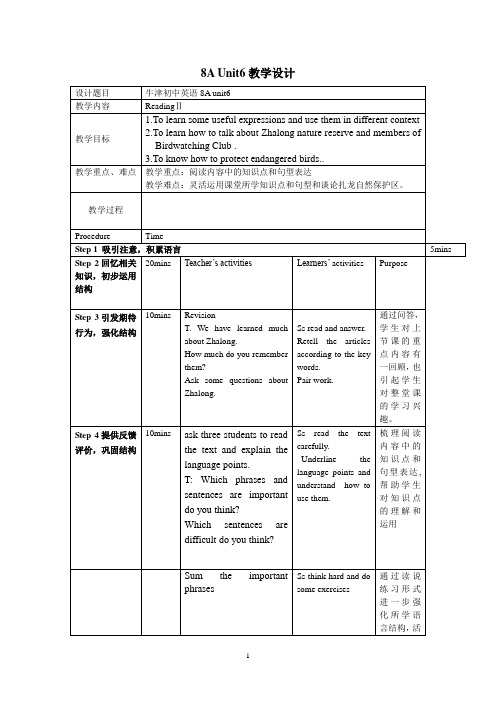
ask three students to read the text and explain the language points.
T: Which phrases and sentences are important do you think?
Which sentences are difficult do you think?
3.To know how to protect endangered birds..
教学重点、难点
教学重点:阅读内容中的知识点和句型表达
教学难点:灵活运用课堂所学知识点和句型和谈论扎龙自然保护区。
教学过程
Procedure
Time
Step1吸引注意,积累语言
5mins
Step 2回忆相关知识,初步运用结构
20mins
Teacher’s activities
Learners’activities
Purpose
Step 3引发期待行为,强化结构
10mins
Revision
T.We have learned much about Zhalong.
How much do you remember them?
通过读说练习形式进一步强化所学语言结构,活跃课堂气氛。
Make an interview in pairs to talk about Zhalong and how to protect endangered birds.
Homework
1 .write an article about how to protect wildlife.
Ss read the text carefully.
牛津8A Unit 6第1课时教案
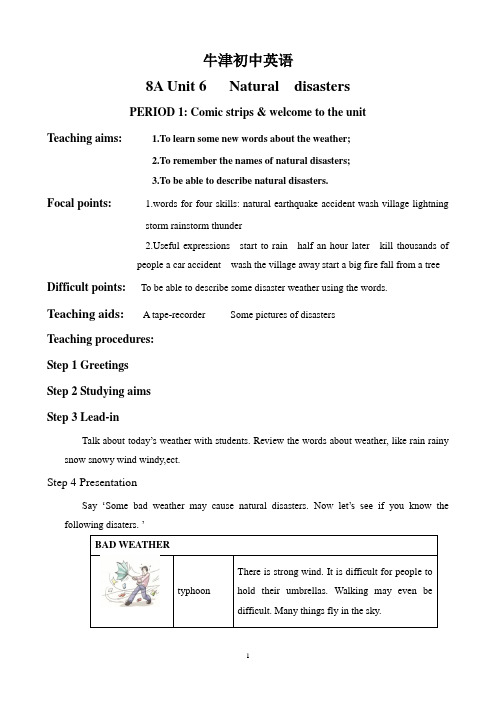
牛津初中英语8A Unit 6 Natural disastersPERIOD 1: Comic strips & welcome to the unitTeaching aims: 1.To learn some new words about the weather;2.To remember the names of natural disasters;3.To be able to describe natural disasters.Focal points: 1.words for four skills: natural earthquake accident wash village lightning storm rainstorm thundereful expressions start to rain half an hour later kill thousands ofpeople a car accident wash the village away start a big fire fall from a tree Difficult points:To be able to describe some disaster weather using the words. Teaching aids: A tape-recorder Some pictures of disastersTeaching procedures:Step 1 GreetingsStep 2 Studying aimsStep 3 Lead-inTalk about today’s weather with students. Review the words about weather, like rain rainy snow snowy wind windy,ect.Step 4 PresentationSay ‘Some bad weather may cause natural disasters. Now let’s see if you kn ow the following disaters. ’For stronger classes, it is necessary to introduce more bad weather, like storm and sandstorm etc.Put it clear that bad weather sometimes can cause disasters (Teach the word ‘disaster’ and explain it in English ‘A natural disaster is a very bad accident caused by natural forces. It usually causes great damage or loss of life.’) Show pictures about the disasters and elicit the disasters, like flood, drought, tsunami, and hurricane, and earthquake etc.Step 5 PracticeStudents listen to the descriptions and tell if they are accidents or disasters.Get the students to finish the exercises in Part A and then check the answers.Emphasize that natural disasters are caused by nature forces usually with great damage and lossof life. Accidents are things that suddenly happened. No one plans it. Sometimes they are caused by people’s mistakes.Explain some of the language used here and help the students to understand.Step 6 PresentationShow the following picture to the students. Get them to guess what happened.Encourage the students to be creative and try to make different kinds of guesses. Get the students to listen to the tape and find out what happened.For weaker classes, get the students to talk about each picture.Get the students to read and practice the dialogue and then act the dialogue out. Encourage the students to add something to make the dialogue funnier.Step 7 AskingStudents read the words and sentences on these two pages and try to find out anything they don’t understand.Step 8 Language pointsTeacher explains something important to students. Students try to remember them.Step 9 ActivityDiscussing about the bad weather and disasters, get the students to discuss about the bad weather and disasters.Suppose there is very bad weather or a disaster somewhere, get the students to work in pairs as reporters and cameramen and try to report it.Ask the students to show their feelings and to act out the behaviors of people in the bad weather.If there is a strong wind, they may feel hard to walk and hard to hold the umbrella.Step10 Exercises。
8A_unit6_全单元教案
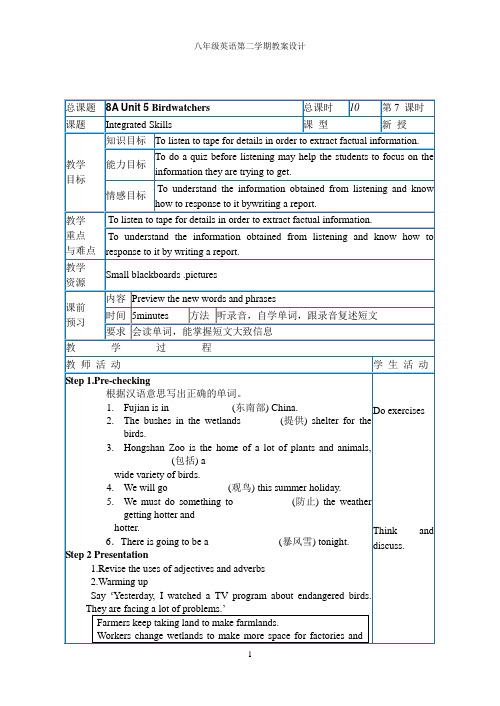
1.Put the information into the sentences and get the students to read the sentences loudly.(P art A on Page86)
2.Listen and repeat.
3. CompleteSandy’s report on Zhalong.
2.Master the expression of invitation:
Would you like to…?
1.Translate messages
Show two messages to the students to guess the meanings:
能力目标
To develop some ideas about how to take notes.
情感目标
The ability to express agreement or disagreement appropriately.
教学
重点
与难点
To invite people at the same time give the information about times, places and activities .
教学过程
教师活动
学生活动
Step 1.Pre-checking
A.写出下列单词的缩略形式:
1.the United Stats of America________2.in the morning _______
B.写出下列词的符号形式:
1.percent____2.because___rmation____4.and___5.dollar___
8AUnit6教案

8A Unit6 Natural disasters教学设计第一课时Welcome to the unitTeaching aims:To introduce the topic of disaters.To identify vocabulary related to disasters.To identify weather conditions and label pictures with correct words.Focus and difficulties:To recognize the weather conditions and natural disaster.Teaching methods:Communication and descriptionTeacing aids:recorder Multi-media computerTeaching procedures:Step1 Lead in :T: What ’s the weather like t odaySs: ItRevise some other words about rain, snow, wind.Step2 Presentationsome pictures of snowstorm that happened inChina during last Spring Festival.Get them to answer the questions about it.﹙1﹚ .Do you like snow in winter﹙2﹚ .Do you think too much snow is good or bad for peoplestudents to tell their ideas.Show more pictures of bad weather.Ask: What caused the trouble or problemsHelp students to answer : nature. They are natural cause the bad weather .They make people get into the trouble.Step3 Practice: Do you know what other natural disasters What words do we use to talk about bad weatherElicit from students other bad weather conditions. ( rainstorm,snow storm, Read the words in Part B and ask more able students to describe eachweather condition only with simple phrases and words.3. Help Ss to complete the task on their own and check the correct answers with the class as a whole.more pictures of natural disasters,help students to know their names and describle them. Help students to use the Past Continuous Tense to talk about the pictures.5.T: Can you distinguish natural disasters from disasters caused by other r easonsGet them to look at part A on P93 and try to finish this partcheck the correct answers with the class as a whole,then read together.Teach some new words.Step4 ActivityDivide the students into groups of four to discuss. Bring some photos to each group and ask students to write a headline about natural disasters or accidents.Step5 Presentation: Look at the pictures ,people suffered from these natural disasters . What can wedo to help will discuss it warmly. Then teacher leads students to the comic strip.:Hobo has some trouble. What happened to him Let ’ s have a look. Students look at the pictures. Teacher asks someopen questions about each picture.1).What ’s the weather like( It’s raining)2). What happened to Hobo( He got wet.)3).What was Hobo doing when it started to rain ( He was sleeping)4).Did he hear the rain ( Half an hour later.)5).What do you think happened o Hobo’s house(The floor was all wet.)6). Why doesn ’t he want to go home alone(Because he wants Eddie to mopall the water up)7).Will Eddie help him(No. I don’t think Eddie likes his idea.)2.Play the tape and students read after it.Explain some language points.StepAsk students to role-play the conversation.Step :Revises the contents we have learned.Preview Reading牛津英语8A Unit6 Natural disasters教学设计Reading(1)Teaching aims:infer the meaning from the key words,pictures and the context.elicit any information about the earthquakes in Taiwan orin other parts of the world.develop the Ss’ability and skills reading comprehension andlet the Ss learn how to describe natural disasters and how o protectthemselves in the natural disasters.Difficult points:The key words and phrases the comprehension of thestory.Teaching methods: reading and talkingTeacing aids:recorder Multi-media computerTeaching procedures:Step1 Lead in :T: we have learnt some natural disastrs last time .What disasters havewe leartEncourage students to say something about the natural disasters. Show some picturs of an earthquake that happened in Wengchuan,sichuan on May12,2008 .Step2 Presentationthe students guess the new words by showing the pictures and talkabout the earthquake that happened in Sichuan.: What do people often feel/do when the earthquake happened some newwords and phrases.shake v.摇动,震动(shaking n.)hear a big noise like thunder听到一声像打雷同样的声音in fear (be frightened)惧怕,惧怕Scream v.尖叫run in all directions奔向四周八方run wildly疯狂地奔跑fall down掉下来come down坍毁,塌陷learning these newwords ,help students finish PatrB1. Check it together. : There was an earthquake in Taiwan in 1999. Manypeople lost their lives in the earthquake , but a boy called Timmy surrived. Let ’s listen to the story to see what happened to himStep3 Listening and skimingthe tape for Studenets and check general understanding by asking some‘ wh’ questions and doing exercises PartC.skim the passage and do exercises on PartD.Step4 Reading and answering1. Listen and read after the tape one paragraph by one if they understand by asking more questions about the passage.the students to read the whole passage in front of the them to mime and gesture in order to illustrate the different aspects of the experience.Step5. Practicestuednts to read the sentences in the boxes in PartC and fill in the blanks. Check the answers with the whole class.the students into groups of the story ,then encourage some of them toretell in front of the class.Homeworkthe new words .to read the story as fluently as you can牛津英语8A Unit6 Natural disasters教学设计Reading(2)Teaching aims:scan the passage.explain some difficult and important language points and to use the m.make an interview about the earthquake.Difficult points:some language structuresTeaching methods:reading and talkingTeacing aids:recorder Multi-media computerTeaching procedures:Step1 revision1.Revise the names of natural disasters.the students the photos of the story of Taiwan earthquake and help themto retell it.Step2 ScanningScan each paragraph and encourage the students to tell their difficulties. Teacher helps students to solve them. Teacher explains language pointsto students.shaking (n.)震动,摇动Fear (n.)惧怕,惧怕一阵惧怕a moment of fearin fear direction 在惧怕中方向,方向人们四周逃散。
牛津英语8A Unit6 integrated skills课件

2.能力目标 2.能力目标 1)能够报告或转述一起事故或自然灾害。 1)能够报告或转述一起事故或自然灾害。 能够报告或转述一起事故或自然灾害 2)能够从所听事故报告材料中获取所需信 2)能够从所听事故报告材料中获取所需信 息并做记录。 息并做记录。 3.情感目标 3.情感目标 引导学生关注自然灾害对人类造成的影响 ,并学会在事故发生时如何求救。 并学会在事故发生时如何求救。 五、教学重难点 能够准确地从听力材料中获取所需信息。 能够准确地从听力材料中获取所需信息。
Date of call
28th January
Time of call 7.40 p.m. Time of arrival 7.45 p.m. (n. 到达 到达) Starlight Street, Sunshine Place Town No. of victims Two Mr Su: OK, but felt cold and Conditions of frightened victims Mr Su: hurt her left leg Arrived at Sunshine Hospital Action at 7.55 p.m.
说明 本课时是8A 本课时是 Unit 6的Integrated skills。 的 。 学生通过听一段有关交通事故的求救电话, 学生通过听一段有关交通事故的求救电话, 学会从中获取有用信息,记录下来,并能 学会从中获取有用信息,记录下来, 够向别人转述。通过 部分的学习, 够向别人转述。通过Speak up 部分的学习, 学生要能够谈论经历过或听说过的自然灾 害。
Part Two While-listening A1 Completing the rest part of the accident report form in Part A1 on page 102
八年级英语上册《8A Unit 6 Natural disasters》教学案 牛津版

Was anybody hurt?
3.Practice the dialogue in pairs and try to act it out
Step4. Making a new dialogue.
Each team can choose one natural disaster to talk about.
Listen and write.
Listen and answer.
Listen and complete.
Read and write.
Step9. Homework &
consolidation
Read and remember
Discuss and write(whiteboard)
Watch and discuss.
Listen and answer.
Practice and act.
Work in pairs and make a new dialogue.
8AUnit 6 Natural disasters(Integrated skills)教学案
课程分析:(本课的总体思路和学习本课的意义)
本课主要让学生通过听,说, 看, 写的方式了解天气和自然灾难,并学会在遭遇这些灾难时如何逃生。通过多媒体手段,可以直观,生动地让学生了解到自然灾难的可怕性。这样可以提供学生生动的描述画面,谈论所看到或听到的灾难场面,教材中还提供了一个对话作为模式,学生视需要可以采用这个模式,也可以自由对话。通过对话,更深一步了解天气和自然灾难的关系。继而通过听一则由天气引起的事故加深学生的认识。并学会如何拨打求助电话,以获得及时的帮助。当然本课主要要让学生明白:恶劣的天气可能引发自然灾难,我们应该怎样面对这些灾难,采用什么样的逃生方式最有效,我们应该以什么样的心态,心理素质去面对等等问题。从而达到学以致用。所以处理这一块内容,我选用了集体探讨,然后师生一起得出结论。最后拓宽学生的思路,将话题扩展到:如何面对我们生活中常见的自然灾难,这时我通过列举安全措施让学生判断该如何做来达到这一教学目的。
牛津英语8AChapter6Morepractice教学设计

牛津英语8AChapter 6 More practice教学设计长治市城区一中秦华ⅠTeaching ObjectsⅰKnowledge objects1) Useful words and expressions2) Main ideas of the passageⅱ Ability objectsReading and communicative abilityⅲ Moral objectsTo get the Ss learn to protect trees and our environment.ⅡTeaching Focuses and Difficultiesⅰ How to use the useful expressions in the passage.ⅱHow to use the knowledge they’ve learnt in the extra reading material to learn the benefits of trees and try to protect trees.Ⅲ Tea ching ProceduresStepⅠ Warm-upConversation competition〔设计意图〕通过几分钟俩俩对话(校本教材)课前热身竞赛,给学生开口说和展示自己的机会,促进他们大胆讲英语,并提高他们的合作竞争意识。
StepⅡ Lead-inⅰ.Draw a picture of a tree on the blackboardⅱ.Ask some questions about trees and introduce an organization “Trees for Life” to students.ⅲ.Talk about the benefits of trees that they know.〔设计意图〕简笔画直观导入教学内容,为任务的呈现做准备。
牛津8A Unit6 Welcome to the unit By Jin Chaohua 教案
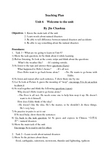
Teaching PlanUnit 6 Welcome to the unitBy Jin ChaohuaObjectives: 1. Know the main task of the unit2. Learn words about natural disasters3. Be able to tell difference between natural disasters and accidents4. Be able to say something about the natural disasters Proceduces:1.Task 1—What are we going to learn in Unit 6?1) Show the task question, let Se think about it while learning2) Before listening. Ss look at the comic strips and think about the questions:What’s the weather like? --It’s raining outside.3) Ss listen to the tape and answer these questions (facts):What happened to Hobo’s house? --It’s all wet.Does Hobo want to go back home alone? --No. He wants to go home withEddie.4) Ss listen and repeat after each sentence, T show them one by one5) Let Ss look at Picture 4, guess the meaning of “mop”, encourage S to do an action to show it6) Ss read together and think the following questions (open):Why doesn’t Hobo want to go home alone?--The floor is all wet. He needs some one to help him mop it up. He doesn’t want to do it himself.How does Eddie think of the idea?--He doesn’t like the idea. He’s the master, so he shouldn’t do these things.He’s very lazy.7) Ss practise in pairs to act it outIf Ss need help, show them the sentences8) Go back to the task question, let Ss guess and express in Chinese “自然灾害”—natural disasters9) Show the main task of the unitEncourage Ss to read it out for others2.Task 2—Learn words about natural disasters1) Show Ss the pictures about them:flood, earthquake, rainstorm, snowstorm, thunder and lightening, typhoon2) Ss do Ex (Part B) to check themselves3.Task 3—Tell the difference between natural disasters and accidents1) Ss do Ex (Part A)Ask Ss to guess the meaning of new words2) Check answers. Encourage Ss to read the sentences and then give out their answers3) Learn new words according to more pictures and model sentence4.Go through all the new words, read them5. Task 4—To be a news reporterSs work in groups of fourChoose a kind of natural disaster to talk aboutReport one by oneRemind Ss: Work as a team, help each other6.Draw a conclusionScientist sayThere are more natural disasters today than before.Why?Protect our world/ motherland.7.Homework8.EndingIf we want to hear birds singing, hear the beautiful sound of the forest. Let’s start to protect the environment.Let’s end our class in the beautiful music. That’s all for today. Goodbye, everybody.。
八年级:牛津英语8AUnit6Naturaldisasters学案

初中英语新课程标准教材英语教课方案( 2019—2020学年度第二学期)学校:年级:任课教师:英语教课方案 /初中英语/八年级英语教课方案编订: XX文讯教育机构牛津英语 8AUnit 6 Natural disasters教案教材介 : 本教材主要用途通学英的内容,提高学生的言技术,增添一言能力,有益于国化的平时沟通、生活、工作等,本教课料合用于初中八年英科目 ,学后学生能获得全面的展和提高。
本内容是依据教材的内容行的写,能够放心改正整或直接行教课使用。
unit 6 natural disasters: comic strips and welcome to the unit (第一)班 _____ 姓名 ____ 成 _____学目1.通漫画引出自然灾祸的。
2.初步接触去行。
3.认识几种自然灾祸的英文名称。
前准达成以下。
1.一自然灾祸 _____2. 掉比 _____3.把⋯拖洗干 _____4. 冲乡村 _____5. 引一大火_____6.撞到一棵_____7. 从上掉下来_____ 8.死不计其数的人_____讲堂学习一.听 comic strip部分对话,回答以下问题。
1. what's the weather like? ______2. what happened to hobo’s house? _______3.what was hobo doing when it started to rain? ______4.when did hobo hear the rain? _______讲堂检测一.依据句意、首字母或中文提示达成单词。
1.i don ’ t like living in a noisy city. i hope to live a quiet life in a v____.2.there are many n_____ disasters every year.3.you should turn off your computer when there is l____ in the sky.4. they went to school in the rain, soon they got all ____ (湿润的).5. the snow and ice on the road caused many ____ (事故) last week.二.用所给动词的正确形式填空。
- 1、下载文档前请自行甄别文档内容的完整性,平台不提供额外的编辑、内容补充、找答案等附加服务。
- 2、"仅部分预览"的文档,不可在线预览部分如存在完整性等问题,可反馈申请退款(可完整预览的文档不适用该条件!)。
- 3、如文档侵犯您的权益,请联系客服反馈,我们会尽快为您处理(人工客服工作时间:9:00-18:30)。
8A Unit 6 Natural Disasters
——Comic Strip & Welcome 教案
丹阳市华南实验学校周文君
Teaching aims and demands:
1. To get to know some names of different bad weather and natural disasters.
2. To know the difference between natural disasters and accidents.
3. To learn how to talk about natural disasters.
4. To Develop students to speak up actively.
Main Points:
1.The new words
2.How to talk about the natural disasters.
Difficult Point:
1.How to talk about natural Disasters.
Teaching procedure:
Step 1 Warm up
1.I’m your new teacher, have a free talk with the students.
2.Talk about the weather.
3.What’s the weather like in the picture?
Step 2 Comic Strip
1.What’s happening to Hobo? Watch a video, and think about two questions.
(1) What was Hobo doing when it started to rain?
(2) What did Hobo want Eddie to do?
2. Listen to the tape and repeat.
3. Act the dialogue out.
Step 3 Bad weather and natural disasters
1.The floor is all wet. If it rains heavily, it is a “rainstorm”, teach “rainstorm”. What bad weather do
you know?
2.Show them some pictures, teach “rainstorm”, “thunder and lightning”, “typhoon”, “snowstorm”.
3. A rainstorm may cause a flood. Teach “flood”. A flood may wash the village away. Teach “wash …
away”.
Lightning may cause a forest fire. It can start a big fire in a house. Teach “start a big fire”.
4.Bad weather may cause natural disasters. Teach “natural disasters”.
Flood and forest fire are both natural disasters, what other natural disasters do you know?
Ask Ss to say some, then show them some pictures. Teach “earthquake”, “tsunami”, “sandstorm”, “tornado”.
5.Read the words by themselves and prepare for the 1st competition.
6. A competition
Watch a video, try to find out the natural disasters in it,
Step 4 Accidents
1.Look at this picture, is this a natural disaster? (No.) It’s an accident. Teach “accident”, look at the
second picture, what happened to the car. Show “A car crashed into a tree.” Teach “crash… into…”.
2.In our books there are 8 pieces of news. Read and judge if they are natural disasters or accidents.
Read by themselves and then check.
3.Read them. Boys read the sentences about accidents, and girls read the sentences about natural
disasters.
Step 5 Discussion
1.What will happen when natural disasters come? First, teacher shows them an example. (about flood)
2.Ask the Ss to talk about the pictures about the earthquake, snowstorm, typhoon and fire by using the
sentence structure “When … happens, ...”.
Step 6 Report
1.Imagine you are a reporter from CCTV, some natural disasters happened, try to report to us, when
you report, pay attention to your pronunciation and intonation, and you can also use your body language if possible. Show them some useful expressions.
2.Ask them to discuss in pairs, and then have a report.
Step 7 Discussion
1.What can we do to reduce natural disasters?
2.Ask them to discuss in pairs and then have a check.
Step 8 Homework
Try to find more ways to reduce natural disasters.。
